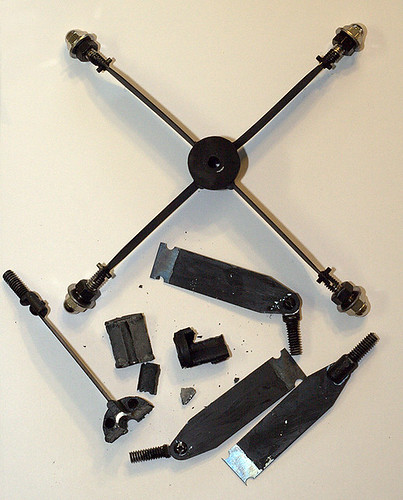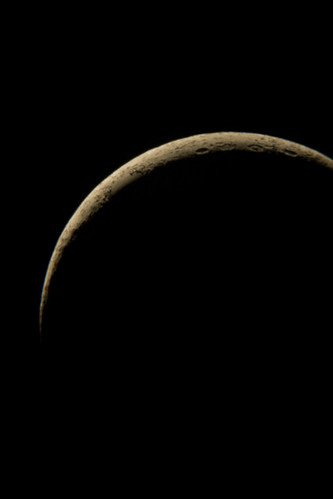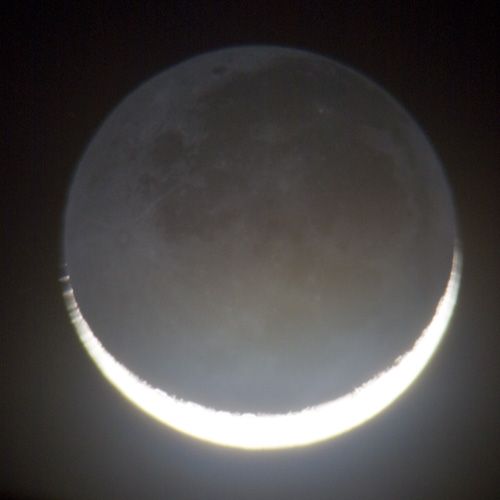In the weeks following, I took my scope out to the front yard several times. I observed more Messier objects than I ever had before (mainly because I'd never tried before--as a kid, I was strictly a planets kind of guy). I spotted M13, the great globular cluster in Hercules, and M92 a cluster a short distance away. Fun stuff, even if my neighborhood is lousy with light pollution and seeing is crummy at best. When all else failed, I could always fall back on the moon. But what I was really waiting for was a star party with the folks from the New Braunfels Astronomy Club. August came, and I was raring to go. I just had to re-collimate my scope, since I'd moved the mirror the night before to try some prime-focus astrophotography. When I was tightening the screws to adjust the secondary mirror... the spider assembly collapsed. Crumbled, actually. The cheap aluminum axis literally broke into dozens of pieces. There was no way I could fix that on my own, so I had to shell out $50 for a Parks spider vane replacement from Scope City.

Closer examination showed that the secondary mirror holder had deteriorated and needed replacing as well, but could wait (and has waited). Also, the secondary mirror needed re-coating. Grr. But with two weeks lost, I was finally able to get everything put back together and a rough collimation completed. Then I hauled the scope (and family) out to Canyon Lake for the New Braunfels Astronomy Club's September star party. Well, the star party gave mixed results. Only one other guy had set up (an 8" Schmidt-Cassegrain) so I didn't have much to compare/contrast my scope's performance against. And there was lots of high haze, so seeing was iffy at any rate. My kids ran wild, and The Wife and I spent more time worried about them destroying some piece of expensive equipment or falling in the dark than with actually looking through the scope. I managed to find M8, the Lagoon Nebula, early on and got a good, if hazy look. But I wasn't able to get a good polar alignment and overall I didn't get as much out of it as I'd hoped. But I did manage a couple of interesting long-exposure red light photos from that night:


And then those photography courses I took at Texas State during the fall semester kicked in full blast and weeknight observations were pretty much out of the question from that point on. But with classes winding down in early December, I started back with the scope. Using a compass in the back yard, I managed to get a mind-bogglingly good polar alignment on Christmas Eve when skies finally cleared after weeks of overcast weather. And my goodness, was the seeing brilliant. Crystal clear. Low humidity, no wind. The Pleiades (M45) were utterly brilliant through my 40mm Plossl eyepiece. M42, the great Orion nebula, was a ghostly white billowing stream, and the four stars that make up the Trapezium in the center were incredibly crisp through my 15mm Plossl eyepiece (which has become my favorite, I believe). But it was M37, a stunning open cluster in Auriga, that blew me away. It was utterly brilliant, like a layer cake of jewels gleaming brightly. I also took in the nearby clusters M36 and M38 as well, but neither compared to M37.
Alas, there have been two clear nights since, but seeing has been marginal. Lots of turbulence high in the atmosphere, and high clouds and haze. Last night I attempted to photograph the Orion nebula but the shots just weren't turning out. My polar alignment was off as well, so the scope wasn't tracking well. I did manage, for the first time ever, to observe M31, the famed Andromeda galaxy. I also found M103, a faint open cluster in Cassiopea as well as NGC869 & 884, the gorgeous "Double Cluster" that may make a great photo for me someday, but not last night. For astrophotography I had to content myself with a few moon shots, including this interesting crescent shot with warm colors:

The moon was low on the horizon, so poor seeing coupled with thick, hazy atmosphere resulted in iffy focus. Taking several shots in a row without touching the camera or changing any settings or focus resulted in just as many shots with varying degrees of sharpness. One end of the moon was clear in an image while the other end was blurry. Those were the conditions I was dealing with. Since I wasn't going to get any ultra-sharp, high resolution images of the moon, I thought I'd take advantage of the slender crescent and try to capture some "Earthshine" shots, in which the "dark side" of the moon is illuminated by reflected light from the Earth. This is the result:

Not the best, but not awful for my first time. I must've bumped the scope during the exposure at some point, accounting for the blur of the crescent. But the dark side is pretty clear there. I hope to try this again--perhaps even tonight--under more favorable conditions. One thing has made a huge difference in my astrophotography efforts, and I want to share it with anyone out there who has similar interests. My Canon XTi/400D has a small view finder, and when attached to the scope, images inside are small and dim. This makes focusing extremely difficult. This is not a camera with Live View, after all. I've tried various Hartmann mask configurations with disappointing results. Achieving exact focus was iffy, although they helped me get within a certain range. Then I heard of a different type of focusing screen, the Bahtinov mask. I didn't expect much from this seeming variant on the Hartmann mask, but short of dropping $150 on a stiletto focuser, I didn't have many options. After making one that was the wrong size for my scope (I'm still not sure how that happened) I Exacto-knifed out the proper pattern and rigged up a mask that slipped over the open end of my scope... and wow! The results were instant and obvious, even through my dim camera view finder. There are three sets of diffraction spikes created by the mask when the scope is aimed at a star, or planet. Two pairs of spikes are adjacent to each other and don't move. The third set of spikes moves closer to the others the more in focus the object is, finally settling in the exact center of the other two once focus is achieved. It's very clear, and very little ambiguity. I'm quite happy with the results thus far, and recommend it to anyone.
Hopefully, my next installment won't take so long to file. The New Braunfels Astronomy Club has another star party coming up in mid January, so with luck (and clear skies) I'll have some interesting things to report thereafter.
No comments:
Post a Comment